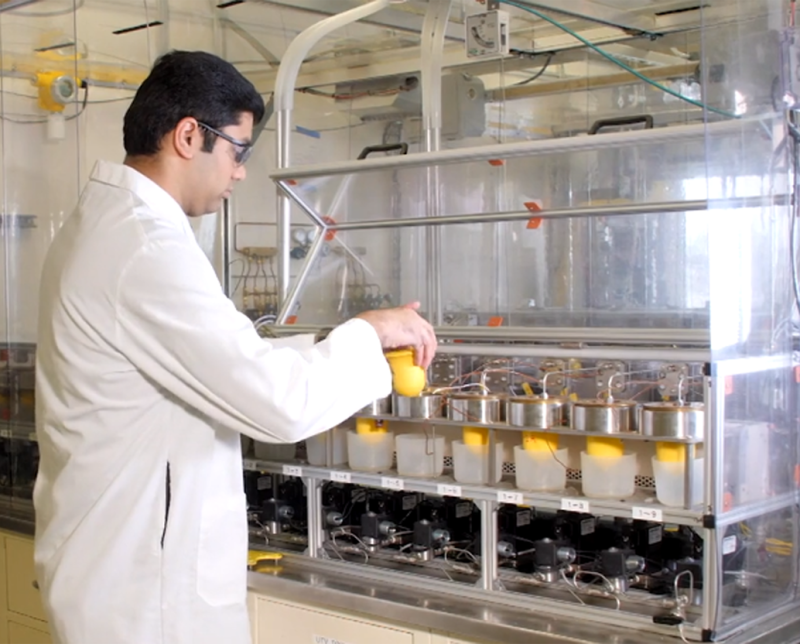GTI Exploring Innovative Hydrogen Production Technology to Enable Expanded Use
By Maddy McCarty, Digital Editor
Hydrogen is a major element involved in decarbonizing the energy industry with the goal of reaching net zero greenhouse gas emissions by 2050. In other words, hydrogen is getting a lot of attention as an energy carrier in the energy transition.

GTI is exploring innovative hydrogen production and generation technology developments to enable expanded use of hydrogen economy wide, as detailed in a Tech Talk this month.
“We’re very excited about the opportunity for hydrogen to play an important role in the U.S. and globally to decarbonize economy wide,” said Kristine Wiley, vice president of GTI’s Hydrogen Technology Center.
The Tech Talk featured GTI’s Markus Lesemann, director, Business Development, Energy Supply & Conversion and Jeff Mays, program manager and principal investigator, Energy Supply & Conversion, who are both working on the advancement of very disruptive, low carbon hydrogen production technologies.
While hydrogen is almost entirely produced for its chemical value now, it is expected to play a major role “due to its energetic value, meaning as a fuel,” Lesemann said.
“Hydrogen can be used for power production, for industrial and residential heat, as well as a transportation fuel, either directly or as a building block for low-carbon fuels,” he said. “Hydrogen is seen to be essential for very hard to decarbonize industrial sectors and it can also play a major role in energy storage.”
This will only happen if hydrogen is produced in a sustainable and affordable way, Lesemann added, noting that currently, most of the hydrogen is produced from fossil resources, like natural gas and coal.
In an increasingly decarbonized world, hydrogen production can use electrolysis, which utilizes a low or no-carbon source like solar energy, or hydrogen production can continue to utilize fossil fuels, like natural gas, but capture and sequester the carbon dioxide emissions. The former is referred to as green hydrogen and the latter is blue hydrogen, Lesemann said.
The fastest ramp up of hydrogen capacity will likely come from a combination of blue and green hydrogen, he noted, adding cost is the main factor that would prevent the industry from going straight toward renewable hydrogen.
Lesemann drew three conclusions about hydrogen in a sustainable energy system based on the International Energy Agency’s 2021 Review:
- Decarbonizing hydrogen production will require rapid electrolysis and carbon capture, utilization, and sequestration (CCUS) roll-out.
- In a net-zero-emissions scenario, blue hydrogen will play a major role in achieving clean hydrogen capacity deployment quickly.
- Investment in CO2 transport and sequestration infrastructure will be needed.
“Blue hydrogen production is expected to remain the lowest-cost option in many parts of the world certainly and can enable a rapid transition toward a hydrogen future,” Lesemann said.
It is more expensive to produce hydrogen while capturing CO2 than it is to produce it without capturing CO2, Mays said. However, some of GTI’s processes and technology, including GTI’s hydrogen generator with inherent CO2 capture (CHG), can reduce the cost.
Steam methane reforming (SMR) is combing methane, steam, and heat, which converts the methane and hydrogen in the water to hydrogen and CO2, Mays explained.
In GTI’s process, adding a sorbent, for sorption enhanced reforming (SER), absorbs the CO2 into a solid phase, like limestone, and gives off heat, he said. The process results in 98% or greater purity CO2 when the sorbent is regenerated, which is then recycled into the system for a loop operation. Mays said this simplifies the process compared to conventional SMR.
SMR to produce hydrogen without CO2 capture costs about $178 million when installed (for a 300 MWth or 236 tpd capacity), while SMR with 90% carbon capture costs about $318 million, according to the presentation. SER costs about $102 million without CO2 capture and $156 million with.
“SER with 90% capture, the capital cost is roughly half that of an SMR, and that reflects in a significantly lower cost of hydrogen, which is the key,” Mays said.
GTI has a hydrogen production pilot project at its headquarters in Illinois, Mays noted, adding that there is another pilot project under construction in the United Kingdom. That project is in partnership with Cranfield University and Doosan Babcock is funded by the UK government, and should be commissioned in the first quarter of 2022.
GTI also has two feasibility studies underway to examine an overall system to use hydrogen for electricity or power generation, Mays said. The system has many novel features, including a unique hydrogen storage system in underground sedimentary rock, which would be significantly cheaper and more prevalent across than U.S. than conventional salt domes, he added.
The Tech Talk showed several examples of how GTI is developing step-out technologies for a sustainable and affordable hydrogen future. An online recording of this Hydrogen Production Tech Talk, along with other sessions on current topics, can be found at gti.energy/techtalk.
Related News
Related News

- Keystone Oil Pipeline Resumes Operations After Temporary Shutdown
- Biden Administration Buys Oil for Emergency Reserve Above Target Price
- Freeport LNG Plant Runs Near Zero Consumption for Fifth Day
- Enbridge to Invest $500 Million in Pipeline Assets, Including Expansion of 850-Mile Gray Oak Pipeline
- Mexico Seizes Air Liquide's Hydrogen Plant at Pemex Refinery
- Evacuation Technologies to Reduce Methane Releases During Pigging
- Editor’s Notebook: Nord Stream’s $20 Billion Question
- Enbridge Receives Approval to Begin Service on Louisiana Venice Gas Pipeline Project
- Mexico Seizes Air Liquide's Hydrogen Plant at Pemex Refinery
- Russian LNG Unfazed By U.S. Sanctions




Comments